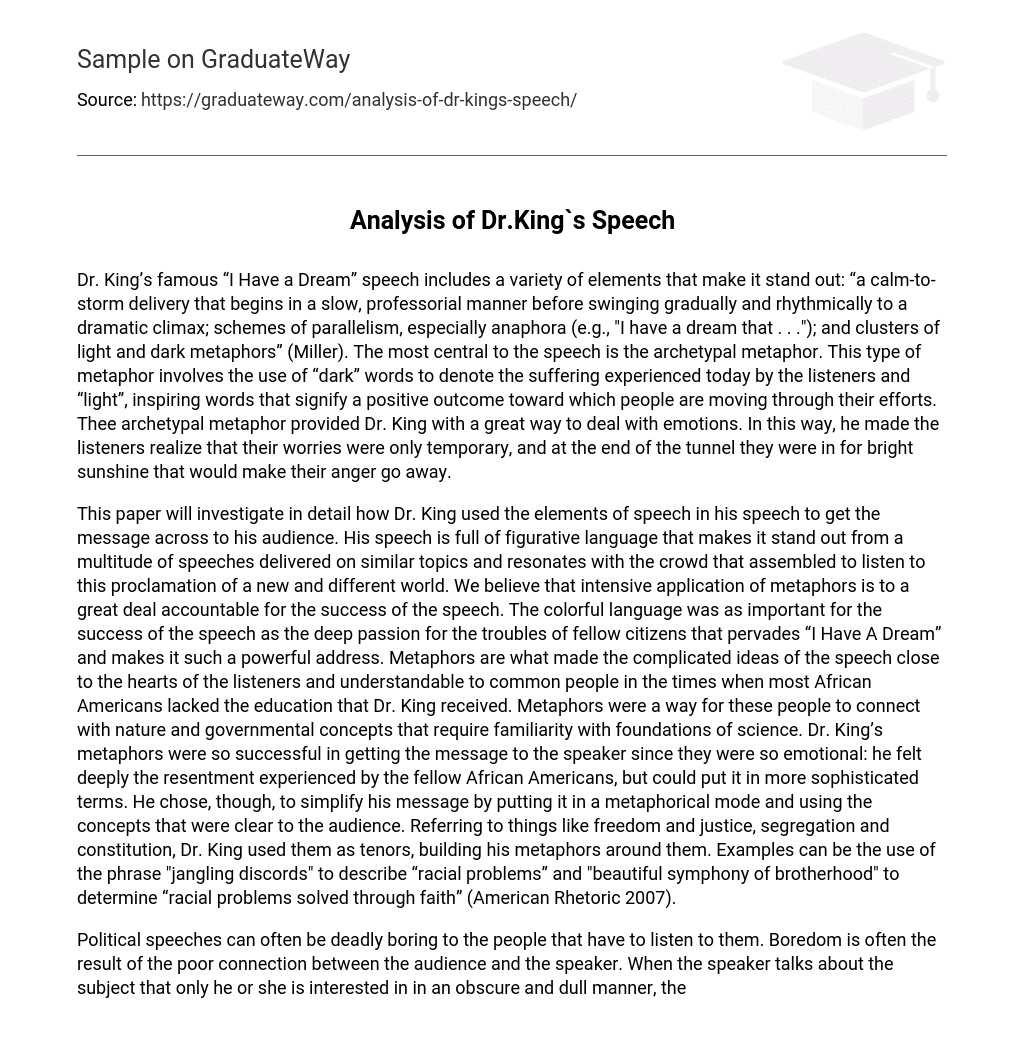Dr. King’s famous “I Have a Dream” speech includes a variety of elements that make it stand out: “a calm-to-storm delivery that begins in a slow, professorial manner before swinging gradually and rhythmically to a dramatic climax; schemes of parallelism, especially anaphora (e.g., “I have a dream that . . .”); and clusters of light and dark metaphors” (Miller). The most central to the speech is the archetypal metaphor. This type of metaphor involves the use of “dark” words to denote the suffering experienced today by the listeners and “light”, inspiring words that signify a positive outcome toward which people are moving through their efforts. Thee archetypal metaphor provided Dr. King with a great way to deal with emotions. In this way, he made the listeners realize that their worries were only temporary, and at the end of the tunnel they were in for bright sunshine that would make their anger go away.
This paper will investigate in detail how Dr. King used the elements of speech in his speech to get the message across to his audience. His speech is full of figurative language that makes it stand out from a multitude of speeches delivered on similar topics and resonates with the crowd that assembled to listen to this proclamation of a new and different world. We believe that intensive application of metaphors is to a great deal accountable for the success of the speech. The colorful language was as important for the success of the speech as the deep passion for the troubles of fellow citizens that pervades “I Have A Dream” and makes it such a powerful address. Metaphors are what made the complicated ideas of the speech close to the hearts of the listeners and understandable to common people in the times when most African Americans lacked the education that Dr. King received. Metaphors were a way for these people to connect with nature and governmental concepts that require familiarity with foundations of science. Dr. King’s metaphors were so successful in getting the message to the speaker since they were so emotional: he felt deeply the resentment experienced by the fellow African Americans, but could put it in more sophisticated terms. He chose, though, to simplify his message by putting it in a metaphorical mode and using the concepts that were clear to the audience. Referring to things like freedom and justice, segregation and constitution, Dr. King used them as tenors, building his metaphors around them. Examples can be the use of the phrase “jangling discords” to describe “racial problems” and “beautiful symphony of brotherhood” to determine “racial problems solved through faith” (American Rhetoric 2007).
Political speeches can often be deadly boring to the people that have to listen to them. Boredom is often the result of the poor connection between the audience and the speaker. When the speaker talks about the subject that only he or she is interested in in an obscure and dull manner, the audience can’t help feeling out of context. “I Have A Dream” is an excellent example of exactly the opposite: a bright and motivational speaker who stepped forward with a message tailored to the people he addressed. He made his ideas clear to a wide audience through the use of archetypal and contrasting metaphors, and he made complex things relate to the audience’s daily lives. The wide use of metaphors made his speech clear and understandable, and in this way added power and energy to the speech. The motivational force of the address has not waned with years. Today, decades after this speech was delivered, millions of people, many of them beyond the boundaries of this nation, put effort and time in studying this great example of public speaking, getting inspiration for their own attempts and trying to uncover the secret of what made Dr. King’s message so memorable to the nation. Following decades of the struggle for civil rights, the dream described so brilliantly by Dr. King, “lives on” in the hearts of the followers (“The Dream Lives On”).
Works Cited
- American Rhetoric. Metaphor. 31 March 2007 <http://www.americanrhetoric.com/figures/metaphor.htm>.
- Miller, Keith D. Martin Luther King, Jr. (1929-1968). 31 March 2007 <http://www.georgetown.edu/faculty/bassr/heath/syllabuild/iguide/king.html>.
- “The Dream Lives On.” Ebony, 59.3 (January 2004): 22.





